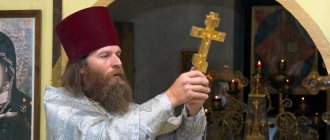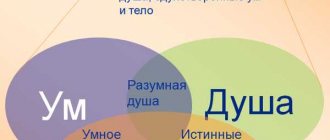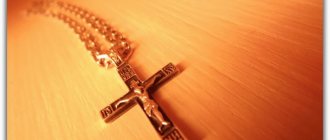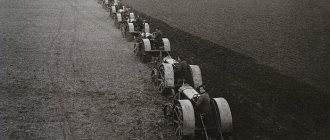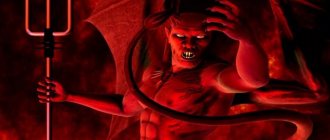- Home page
- •
- Directory of Church Terms
- •
- Clergy clothing
In this section we will talk about the clothes that bishops, priests and deacons are called to wear during non-liturgical times. According to church canons, these clothes differ from secular ones: even while at home, the priest is a bearer of the rank. In practice, this rule is not always observed, which today is not considered a violation of church discipline.
In Dahl's dictionary
m. plant. Agrostemma Githadо, putik, chernukha, weed and seed in bread; also | Lolium tremulentum, smut, chaff, newborn. Sow grain and a crop will be born. Smerd is like a cockle: gray on top, but white on the inside. | Vyat. doll, flax husk. Pupa, plant. Меlandrium pratensе, Kulyshin resident? forest nutcracker, forest cockle. | Plant. Silene inflata, rattles, nutcracker, crippled, mad cucumbers, falcon flight. M. DOLL and female doll. cape, cap sewn to the collar of clothing; vidloga, bashlyk, head cap, capishon, sul. Monastic kukul or kukul, see apostle. | Arch. separate canvas hood, with ties in the form of ears, against mosquitoes. | Arch. a shirt with the same cap, worn by seal slaughterers over warm clothing, to match the color of snow and ice, in order to wear down the beast. Puppet, doll-like, related to the doll. (from a doll?).
Patriarch's dolls
Author of the article: Alexander Demidov
Kukol (lat. hood) in the Russian Church since the 17th century after the reforms of Patriarch Nikon is the outer vestment of a monk of the great schema (see schemamonk) in the form of a pointed hood with two long strips of material covering the back and chest; black, with the image of crosses, seraphim and the text of the Trisagion on it. Worn over the robe. In subsequent tonsure it is called the doll of innocence, the helmet of saving hope.
The white kukol is the most noticeable (though not liturgical) difference in the vestments of the Russian Patriarch and represents only the pre-schism form of the monastic hood (the patriarchal kukol has a slightly changed shape of the basting, images of six-winged seraphim are embroidered on the frontal side and front ends of the kukol, a cross is placed on the top of the patriarchal kukol ).
White hoods in Byzantium were apparently worn by patriarchs who were not ordained monks (the origins of this headdress should be sought in the attire of the Byzantine emperors and popes). Moscow metropolitans began wearing a white klobuk in 1564; before that, wearing a white klobuk was only the prerogative of Novgorod bishops (the semi-apocryphal story of how the white klobuk came to Novgorod is reflected in the famous Russian source: “The Tale of the White Klobuk”).
The first bishop to receive the honor of wearing a white hood was Archbishop Vasily of Novgorod and Pskov (1329-1352), to whom the Patriarch of Constantinople sent cross vestments and a white hood.
In 1564, the Moscow Local Council adopted a statute on the right of the Moscow Metropolitan to wear a white hood. After the establishment of the patriarchate in Russia in 1589, Moscow patriarchs began to wear a white hood.
Also, the kukol is part of the non-liturgical vestments of the primates of some Local Orthodox Churches, for example, the Catholicos-Patriarch of all Georgia has a black kukol.
In Vasmer Max's dictionary
I kukolI., m. “weed, chaff, Agrostemma, Lychnis”, Ukrainian. kukil, blr. kukol, bulg. kakal, serbohorv. kukoљ, Slovenian. kokolj, Czech. koukol, slvts. kúkоl᾽, Polish. kąkol, v.-luzh. kukel, n.-luzh. kukel, lab. kǫchǘöl. Praslav. *kǫkol. Lit. kuokalis, lts. kuõkalis, kūkal̨i borrowings. from Russian; see M.–E. 2, 333; 342. Usually considered related to lit. kañkalas "bell"; Wed lit. kankalìjos pl. “bell flower” as an option in relation to slav. *kolkolъ (see bell); Wed Bernecker 1, 539 et seq.; Meillet, MSL 12, 217; Brandt, RFV 22, 139; Solmsen, RVV 27, 365; Thorbjornsson 1, 82; Mahek, Recherches 71. The plant is so named for its bell-shaped flowers; Wed English soskle “core mollusk; Kukol", English-German Klockenblome. The attitude towards other Indians is questionable. kaŋkaṇаs “hoop, ring-shaped decoration”, kaŋkaṇī “decoration with bells” (Guyer, LF 35, 220 et seq.), as well as k kúka “hook”, contrary to Brückner (224; KZ 42, 350; 48, 173). •• (Subsequently, Mahek (Jména, p. 77) put forward a new etymology: Slav. kǫkol- from kolkol- chaff", Latin lōlium; ultimately - from Proto-European. - T.) II kukolII. “hood”, Old Russian, Old Slav. kokol - the same (Kirill Turovsk, etc.), also kukul. Borrowing from Middle Greek κουκούλλι(ον), κουκούλα from lat. cuculla, cucullus; see Vasmer, IORYAS 12, 2, 249; Gr.-sl. this. 104; Bernecker 1, 640; G. Mayer, Ngr. Stud. 3, 33 et seq. The Social-V.-R. probably goes back to this word. doll “hood made of deer fur, linen blanket against mosquitoes”, arkhang. (Followed), so it is not necessary to explain it from Karelian. kukkelí (see kukel), contrary to Kalima (136 et seq.).
The doll and staff for Kirill were made by the best craftsmen
On February 1, the enthronement (entitlement to the patriarchal throne) of the newly elected Patriarch of Moscow and All Rus' Kirill will take place in the Cathedral of Christ the Savior. “MK” found out the details of this ceremony.
The ceremonial service will begin at 9 am - all delegates of the Local Council and several hundred more invitees are expected at the ceremony. Then a gala reception will be held in the chambers of the Cathedral of Christ the Savior.
The moment when Orthodox believers officially receive a new patriarch is indicated by the threefold exclamation “Axios!” (translated from Greek - “Worthy!”). Before this, the newly elected head of the Russian Orthodox Church is dressed in special clothes (by the way, the vestments of the patriarchs of the pre-Petrine era could weigh up to 16 kg, but now - only about 3-4 kg) and a quadrangular plate with an image of a cross is placed on him - a paraman. The symbolism of this action is a reminder of the cross that a church minister takes upon himself.
And after the patriarch ascends to the throne of the high priest, he will be presented with symbols of church authority - a kukol (white headdress) and a staff. The dolls for Patriarch Kirill and vestments were sewn at the Sofrinsky church factory. His patriarchal monogram was also made, which will decorate the things and vestments that belong to him. By the way, each of the eastern patriarchs has its own color. The Russian patriarch traditionally uses green. The late Patriarch Alexy II always carried a pen with a green tip and signed important documents with it.
As for previous enthronement ceremonies, according to ancient custom they were performed in the Assumption Cathedral of the Moscow Kremlin. In 1917, after the election of Patriarch Tikhon (Belavin), with great difficulty it was possible to obtain permission from the Bolsheviks, who were located in the captured Kremlin, to hold the enthronement celebration. On November 21, 1917, on the feast of the Entry into the Temple of the Most Holy Theotokos in the Assumption Cathedral, the newly elected patriarch was enthroned. He was led into the altar and seated in the patriarchal seat by Metropolitan Vladimir of Kiev and Platon of Tiflis, Exarch of Georgia. Then he was given the patriarchal vestments - the day before, from the patriarchal sacristy of the Kremlin they managed to procure the mantle and cross of Patriarch Nikon and the cassock of the patriarch-martyr Hermogenes. After the liturgy, when Metropolitan Vladimir handed him the staff of St. Peter of Moscow with a welcoming speech, the patriarch delivered a keynote speech. Its meaning boiled down to the fact that the patriarch understood perfectly well in what difficult and troubled days he was ascending to the throne. He made it his mission to save every lost soul...
In 1943, when the enthronement of Patriarch Sergius took place in the Elokhov Epiphany Cathedral, the day before a patriarchal vestment was sewn specially for him, a cross was made, and a kukol, a special patriarchal headdress, was sewn.
From 1945 to 1990, the enthronements of Patriarchs Alexy, Pimen and Alexy II took place in the Elokhov Epiphany Cathedral, since the Assumption Cathedral of the Moscow Kremlin was turned into a museum. The vestments were sewn specifically for each of the patriarchs, since in 1945 the patriarchal workshops were restored, in which the best craftsmen worked. For example, the doll of Patriarch Nikon and the vestments of Patriarch Alexy I are today kept in the Central Archaeological Cabinet of the Moscow Theological Academy.
Paraman is part of a monk's vestment. Worn on the body under clothing on four cords, sewn at the corners in such a way that the quadrangle is on the back, and the cords form a cross on the chest.
The patriarchal paraman is larger than the ordinary one. It is put on by the patriarch over his cassock and only before the service.
Monogram of the late Patriarch Alexy II. Similar symbols contain the initials of the head of the Russian Orthodox Church and are used, for example, on patriarchal letters or on a flag mounted on the patriarch’s car. By the way, Alexy II was often given gifts with his monogram - say, vases. And a few years ago, a young blacksmith from the Moscow region even forged a monogram for the patriarch.
Only the Patriarch of All Rus' can enter the altar through the Royal Doors during services with a staff. Other bishops, entering the altar, give the staff to the subdeacon, who holds it in his hands, standing to the right of the Royal Doors. A distinctive feature of the patriarchal staff from the “ordinary”, archpastoral ones, is that it does not have a sulka. (This is the name of a quadrangular board folded in half, tied to a staff at the top. Sulki began to be used because of Russian frosts - so that the hands of the clergy did not freeze.)
Cocoon (Agrostemma L.)see also Chapter II PLANTS THAT PRIMARILY CAUSE SYMPTOMS OF DAMAGE TO THE GASTROINTESTINAL TRACT AND SIMULTANEOUSLY AFFECT THE CENTRAL NERVOUS SYSTEM AND THE KIDNEYS
Cockle.
Botanical information.
Clove family (Caryophyllaceae).
Cockle
(Agrostemma githago L.). Annual plant. Stem 30–80 cm high, simple or branched; leaves linear or linear-lanceolate, 5-13 cm long; the flowers are large, solitary, located at the ends of the stem and branches, dark pink; fruit capsule; the seeds are more or less large (up to 3 mm), black, covered with spines.
A common plant. Grows like a weed.
Toxic substances and their effects.
The main active ingredient in cockle is a saponin - gitagin. It is deposited mainly in the seeds of the plant; its amount can reach up to 6%.
Toxicological significance.
From a toxicological point of view, cockle seeds can be of practical importance. The degree of toxic effect of seeds on animals of different species and on animals of the same species is not always the same. This is explained by the fact that the toxicity of cockle depends on a number of conditions: soil and meteorological characteristics in the place where the plants grow; the state of the digestive tract of animals exposed to poisoning; type of animals, conditions and duration of storage of feed suspected of being contaminated by cockle, etc. Based on special experiments, the Kazan agricultural farm even came to the conclusion that cockle is completely harmless for cattle and sheep and about its suitability for feeding these animals (“Vedomosti” agriculture and industry”, 1905). It is apparently impossible to accept these conclusions as correct for all cases, since they contradict the facts of natural cockle poisoning of cattle and sheep observed at different times.
Cases of natural cockle poisoning were observed in all domestic animals: horses, cattle (P.F. Chukh and others), pigs, sheep.
The cause of poisoning in these cases was feeding the animals with bran, rye, barley, cakes, mill screenings with an admixture of cockle. The percentage of contamination in different cases ranged from 1.4 to 95. The duration of feeding of animals before the appearance of clinical symptoms was different: chickens - 1 day when the feed was 95% clogged with cockle seeds; pigs weighing 115-150 kg - 3 days with 6% contamination and with a daily supply of 1.5-2 kg of contamination of feed, pigs in another case - 14 days with 50% contamination of bran; horses - 20 days with 1.4% clogging and with a daily supply of 5.5 kg of clogged grain; calves - 28 days with a contamination amounting to 40 cockle seeds per 400 grains of rye. Daily feeding of 800 g of cockle seeds causes poisoning phenomena in pigs on the third day (according to the above-mentioned experiments at the Kazan agricultural farm).
Apparently, young animals are especially sensitive to cockle venom. In a specially designed experiment, poisoning of calves (aged 2-2 1/2 months) occurred from cockle seeds given daily in an amount of 4-5 g for 18 days (A.P. Onegov).
Among birds, cockle poisoning has been observed in chickens and geese. The degree of contamination of feed by cockle in case of poisoning of chickens was 8% in one case, in another - 95% (G.N. Avtandilov), in case of poisoning of geese - 40-50%.
The toxicity of the feed at 8% contamination with cockle seeds was tested experimentally: two chickens that were fed 15 g of cockle each (as an 8% admixture to the feed) died, one after 5 days, the other after 12. Disease in geese with 40-50% feed contamination occurred soon after feeding. At the same time, the poisoning was very acute: the death of most of the geese (263) followed within 24 hours. Chickens that ate food that was 95% contaminated died within 2 days. One-time feeding of 50 seeds (0.5 g [The absolute weight of one seed is 0.007-0.010 g]) to 14-day and 3-week chickens, 2- and 3-month-old chickens and 100 seeds (1 g) to a 2-month-old chicken none did not cause any disturbances in the health of the birds.
Clinical picture.
Cockleaf saponin, as stated above, has a strong irritant effect on the gastrointestinal tract. In case of cockle poisoning, the first symptoms that occur are drooling, nausea, vomiting (especially in pigs), sometimes with blood, difficulty swallowing, colic, and diarrhea. Further development of the clinical picture is associated with the general effect of the poison. It manifests itself in general weakness, depression, weakness of the heart, convulsive states, signs of severe irritation of the kidneys and, finally, the onset of paralysis.
In severe cases of poisoning, sick animals lie helplessly or stand indifferently with their heads bowed; refuse food; when moving, they barely step, staggering from side to side. The pulse is weak, rapid, barely perceptible, the heart beats are strong, the conjunctiva is red, often icteric. There is copious discharge of urine, sometimes colored red. General random spasms or convulsive contractions of individual muscle groups appear. Body temperature, initially normal, may increase with the development of inflammatory conditions. Animals may die within 1-3 days.
In the above-mentioned experiment with calves, a severe illness was observed with signs of damage to the gastrointestinal tract, kidneys, nervous system and a sharp drop in weight. The development of all these disorders in one animal proceeded as follows.
- feeding a cockle - general weakness, lethargy, sluggish intake of food; pulse and breathing are increased; mucous membranes are slightly icteric.
- - depressed state; general sensitivity is reduced; the animal lies down and does not respond to the call; gait is unsteady, uncertain; mucous membranes of the eyes and mouth are jaundiced; secretion of saliva and secretion of the nasal mucosa are increased; pulse is frequent (90-120 per minute), weak filling, poorly felt; breathing is difficult and rapid (14-35); peristalsis is revived; defecation is frequent; the stool is liquid, has an unpleasant odor, and contains streaks of blood; urine flow is increased, its color is brown-red.
Changes in the blood by the end of the experiment (13th day from the start of cockle feeding) were expressed in a decrease in the number of erythrocytes, leukocytes and hemoglobin content. In white blood, a decrease in the content of eosinophils and monocytes and a regenerative shift to the left were observed. Protein, blood pigments, bile pigments, and urobilin were found in the urine. By the end of the experiment, the weight of the sick calf decreased from 50 kg to 35. Recovery was slow.
The cockle has a similar effect on the condition of birds. As an expression of local painful conditions, birds soon develop a peculiar stretching of the neck and twitching of the head (the impression of gagging); salivation is observed. Subsequently, a general decline in strength sets in; sick birds sit on their feet or fall on their sides; their movements are sluggish; the general state is drowsy, indifferent. Upon closer examination, a icteric discoloration of the skin and mucous membranes, pain along the esophagus and goiter are noticed.
Pathological changes.
When autopsying dead animals, they find signs of inflammation of the mucous membrane of the pharynx, larynx, stomach, intestines, bladder, hemorrhage in all organs and, in addition, in the subcutaneous connective tissue, deep in the skeletal muscles; the blood is bright red, very watery, and difficult to clot. When autopsying dead birds, the following is found: hemorrhagic infiltrates in the subcutaneous tissue along the esophagus, in the chest and collarbone area; the mucous membrane of the esophagus is swollen, with hemorrhages; the mucous membrane of the goiter, in some cases with areas of necrotic changes, is dry, ash-gray in color; the mucous membrane of the muscular stomach and intestines is swollen, hyperemic, with a large number of hemorrhages; the heart is flabby, with hemorrhages under the serous membranes and in the thickness of the muscle; the liver is flabby, clay-colored.
Diagnosis.
If cockleel poisoning is suspected, testing the food can be of great help in making a correct diagnosis. The presence of whole seeds is easily recognized by their characteristic appearance. You can detect cockle in flour or bran by botanical and biological research. During botanical examination using a magnifying glass, attention is paid to the characteristic structure of the skin of cockle seeds: it consists of dentate cells that enter into each other with teeth. The biological method is based on the hemolytic action of saponin. One of the methods for quantitative determination of cocklefish was proposed by F. S. Okolov. This method is as follows.
During the day, 25 g of suspicious food is extracted with physiological solution in a ratio of 1: 5 (25 g of food, 125 ml of physiological solution) at a temperature of 37° and repeated shaking. The next day, the extract is filtered. At this time, a washed mixture of rabbit erythrocytes is prepared: a small amount of blood is taken (from the heart, vein) (5-6 ml of blood is needed for 15-20 food samples); the blood is defibrinated, filtered through gauze, diluted 18 times with saline (1 part blood, 17 parts solution) and washed 3 times by centrifugation (or, in the absence of a centrifuge, settled). Each time after suctioning the upper layer, the liquid level is brought to the original volume by adding saline. Then take 11 small test tubes; 1 ml of extract from the food is poured into the first five, 0.5 ml into the next three, and 0.25 ml of extract into the last three. The volume of liquid in the last six test tubes is adjusted to 1 ml with saline solution. Thus, in the first five test tubes there is a whole extract, in the next three - in a dilution of 1: 2, in the last three - in a dilution of 1: 4. Then a suspension of erythrocytes is introduced into all test tubes: into the first five test tubes sequentially 0.1 ml; 0.2 ml; 0.3 ml; 0.4 ml; 0.5 ml, in the next three - 0.3 ml; 0.4 ml; 0.5 ml and in the last three - also 0.3 ml; 0.4 ml; 0.5 ml. The tubes are left at a temperature of 37° for 11/2 hours and then at room temperature for a day.
The amount of saponin in percentage is determined by multiplying the amount of added blood in the last test tube that gave complete hemolysis by the degree of dilution of the extract. So, for example, if complete hemolysis occurred in the first test tube, then the percentage of cockle will be equal to 0.1 (0.1 X 1), if in the sixth - 0.6 (0.3 X 2) if in the ninth - 1.2 ( 0.3 X 4), etc.
Therapy.
In case of (acute) cockle poisoning, it is necessary to quickly remove the poison from the stomach by administering emetics (in pigs), gastric lavage (in horses) or precipitating the poison with tannin and tannin-containing agents;
after that, laxatives and coatings are prescribed (mucous substances, fats, oils, eggs, milk) and a proper diet is prescribed. To treat birds, in particular chickens, you can use crop washing or even surgical removal of food from the crop; then they give a laxative and prescribe soft food. For the purpose of prevention, it is recommended to fry food contaminated by the cockle in iron pans (sheets). ^ZGL: PUPPET
(AGROSTEMMA L.)
Doll of Patriarch Alexy II - 003
Handmade doll of Patriarch Alexy II commissioned by Sofrino LLC. On the frontal side is placed the Deesis rank (Savior, Mother of God, John the Baptist). On each of the front ends of the dome there are images of saints in a frame with a dome. On the left are Saints Hermogenes, Jonah, Phillip, on the right are Saints Michael, Peter, Alexy. The faces are made by painting on cardboard. The clothes and the pattern of the frames are embroidered with gold and silver threads using the “map” technique. Natural pearls, beads… Read more
From the history of the cassock
Until the 17th century, the Russian clergy did not wear cassocks, but single-row caftans. They could be sewn from cloth of different colors: crimson, purple, green and, unlike the Russian cassock that arose later, had narrow sleeves.
The formation of the Russian cassock occurred under the influence of the penetration of Greek robes for the clergy into our country. At the same time, the Russian cassock became not a copy of the attire of Greek priests, but a kind of “hybrid” between domestic and foreign versions.
Right up to the revolution of 1917, the Russian clergy loved robes of bright colors, for example, crimson. Nowadays, black clothing consistently holds priority, but other tones are also used: dark blue, gray, beige, cream
- especially in the warm season.
Robes of a bishop, priest, deacon
In everyday life, all holders of church rank wear approximately the same clothes: cassock and cassock. When going outside, you put on a headdress - skufya.
.
Initially, these robes originated from the clothes worn by the ancient Jews, as well as residents of ancient policies. It is believed that the cassock and cassock resemble the tunic that the Savior wore.
By the way, the tradition of Christians to differ in appearance from pagans already existed in the Ancient Church. Tertullian (3rd century) mentions that in his time believers wore pali
- a cloak that symbolized simplicity and humility, for which they were subjected to ridicule from idolaters.
Varieties of clergy clothing
A cassock is a split garment that reaches to the edge of the boots, with long narrow sleeves and a closed collar. Most often it is black. In summer, in an informal setting, some priests wear light-colored cassocks: gray, cream, white, beige. Summer cassocks are most often sewn from cotton and linen
in a ratio of 80 to 20, 50 to 50 or
from pure flax
.
, wool and synthetics
are quoted .
The cassock and cassock have Russian and Greek versions.
Russian cassock
fastens end-to-end, odorless. Fitted to the figure.
On the chest of a Greek cassock
pockets are arranged. It is not fitted and has a stand-up collar.
Bulgarian cassock
is something of a cross between Russian and Greek: it has a “Greek” stand-up collar and “butted” floors, like a Russian cassock.
A cassock is a long robe, split in front, which is worn over a cassock; in contrast, it has wide sleeves that fit the palm. The word “cassock” originally meant “poor, worn out clothes.”
Varieties of cassock
The Russian cassock is fastened end-to-end, without a zappa
ha, it has a fitted style. The sleeves are narrow at the shoulders and very wide at the bottom. The collar is fastened with a button. This style suits the harsh climate of our country: it allows you to save heat. At some official church events, the clergy of the Russian Orthodox Church is obliged to appear exclusively in robes of Russian cut.
There are two variations of the Russian cassock: the Kiev one - fitted only on the sides, and the Moscow one - fitted on all sides.
The Greek cassock came to Rus' in the 17th century, when the Great Moscow Council of 1666-1667 allowed the clergy to wear it. This cassock is much wider than the Russian one, is not fitted, fastens only at the collar and chest, and has a stand-up collar. Essentially, this is a transformation of an oriental robe. The sleeves of the Greek cassock are wide along the entire length. This meets the requirements of the hot southern climate, where this type of clothing was formed - Greek robes
made from natural silk. Russian priests gladly wear such robes in the summer, and many clergy prefer them at any time of the year, valuing freedom of movement. In Greece, priests wear black cassocks and cassocks, and the Russian tradition of colored clergy clothing causes them some surprise. Cassocks with satin silk cuffs on the sleeves are common. These lapels can also be colored - for example, purple.
A winter cassock can be insulated with batting or padding polyester and used as a coat. The collar of the winter cassock is turn-down, often made of fur or velvet. However, many priests, even those who constantly wear a cassock, prefer a regular coat or jacket in black. Instead of a skufia, they often wear an ordinary cap or hat.
Helpful advice. Features of sewing cassocks and cassocks
Some seamstresses make the mistake of not taking into account the difference between male and female figures, and the waist of the Russian cassock they sew ends up in the armpit area. Of course, this is wrong: the cassock is not a woman’s dress, and its waist should be in its place. They often sell cassocks and cassocks with unhemmed bottoms - meaning that everyone will tailor them to their height. But if necessary, you can shorten the hemmed vestment. Still, it’s more pleasant to buy clothes that you can wear right away.
Skufja is a black cap that covers the forehead. May have Russian
(more common) or
Greek style
.
In pre-Nikonov times, the shape of the skufia was different from the modern one and resembled a dome. Modern skufya is sewn in such a way that 4 folds
, forming a cross visible from above. The clergy's benches are made of velvety material.
Bishop's robes
The bishop's robe is a type of monastic robe. In everyday life, the bishop wears an ordinary black robe
, and puts on a special one - the bishop's one - when going to divine services, as well as during religious processions. In the temple it is solemnly removed, and the ruler dresses in sakkos.
The mantle is a long and wide garment in the form of a sleeveless cloak. The bishop's robe is fastened in 2 places: at the collar and below, and its length is such that a train is formed.
The bishop's mantle is decorated with tablets - quadrangular plates. On the upper part of the mantle there are two tablets with images of seraphim or crosses, less often - icons, and on the lower part there are two more, with the initials of the bishop. The tablets are reminiscent of those tablets with the Commandments
which were given to Moses on Mount Sinai. They indicate that the source of the bishop’s power in the Church is God, and in his activities the bishop is obliged to be guided by His Law.
Also on the bishop's mantle, evenly distributed along its length, are sewn 3 rows of horizontal ribbons of white and red colors - “sources” (“streams”). They remind us of the teaching of the Church - the Old and New Testaments, which the bishop is called to preach.
From the history of the bishop's mantle
A long, wide cloak - palium - was an attribute of the first Christians, not only clergy, but also laity. He pointed to humility, carelessness, purity of action and readiness to entrust one's life to God.
With the formation of monasticism
the mantle immediately became the attire of its wearers. The robes of desert hermits were simple and practical: they protected from the sun and could be wrapped in while sleeping.
From the 4th century A.D. bishops wore a robe woven from white wool. It was a symbol of a shepherd carrying a sheep on his shoulders, that is, it indicated the bishop’s duty to take care of the salvation of his flock. Since the 8th century, the white mantle has been a sign of the rank of metropolitan.
Symbolism of the bishop's robe
Mantle
- free, fluttering in the wind - symbolizes the wings of an angel, speaks of spiritual heights, prayerful flight. It marks the fullness of Divine grace, which the Lord bestows on those whom He places at the height of hierarchal service.
Here is how St. Simeon of Thessalonica wrote about the monastic mantle: “ The mantle...expresses the all-covering power of God, as well as the severity, reverence and humility of monastic life, and that the monk has neither hands nor other members that live or are free for worldly activities
».
The same saint reported about the bishop’s mantle: “ Tablets or tablets are sewn into the image of ancient and new grace. That is why they are relied upon above the sources: they also mean that the teacher must borrow teachings from the two Testaments
" “His (the bishop’s) mantle means the providing, containing and covering grace of God, and embraces and binds the whole body. Sources show that the teaching always flows from two Testaments, Old and New, which are signified by tablets or tablets.”
